Yesterday was the last of the three big festivals in Kyoto, Jidai matsuri (the other two are Aoi and Gion matsuri). Literally the name translates as Period Festival, but it is better known in English as the Festival of the Ages, and that although it has a history of rather short 120 years only. The first Jidai matsuri took place in 1895, 1100 years after Kyoto had become the capital of Japan, and only a few years after it had lost that place to Tokyo when the emperor moved his household there. Jidai matsuri is – like most of the festivals in Japan – connected to a shrine, and in this case it is Heian shrine (named after the old name of Kyoto: Heian-kyo) , which is a 2/3 scale replica of the former imperial palace, was built also in 1895, and enshrines the first (Kanmu) and the last emperor (Komei) that had Kyoto as residence.
The first Jidai matsuri took place in 1895, 1100 years after Kyoto had become the capital of Japan, and only a few years after it had lost that place to Tokyo when the emperor moved his household there. Jidai matsuri is – like most of the festivals in Japan – connected to a shrine, and in this case it is Heian shrine (named after the old name of Kyoto: Heian-kyo) , which is a 2/3 scale replica of the former imperial palace, was built also in 1895, and enshrines the first (Kanmu) and the last emperor (Komei) that had Kyoto as residence.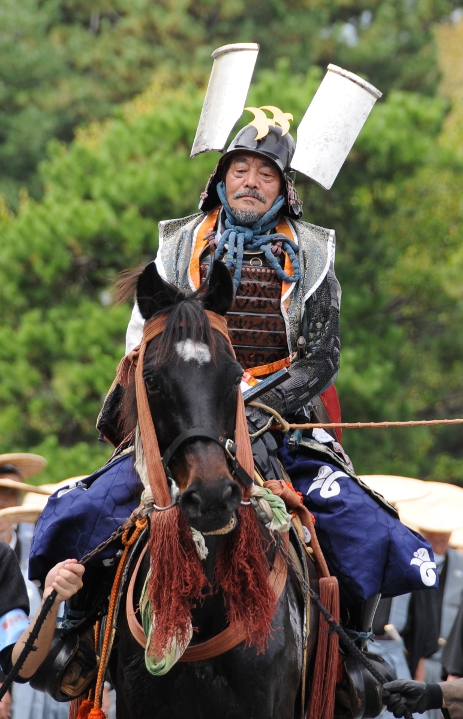 The idea behind Jidai matsuri is to showcase not only Kyoto’s history, but that of all Japan, and this is done with a long costume procession “back in time” from the Meiji era through the long Edo period of peace until the famous Heian era. About 2000 people form the procession, wearing traditional clothing, not only the well known ones of famous samurai going to war or court ladies of leisure, no, also normal people in their work clothing and straw sandals, are walking the streets of Kyoto from the imperial palace to Heian shrine.
The idea behind Jidai matsuri is to showcase not only Kyoto’s history, but that of all Japan, and this is done with a long costume procession “back in time” from the Meiji era through the long Edo period of peace until the famous Heian era. About 2000 people form the procession, wearing traditional clothing, not only the well known ones of famous samurai going to war or court ladies of leisure, no, also normal people in their work clothing and straw sandals, are walking the streets of Kyoto from the imperial palace to Heian shrine.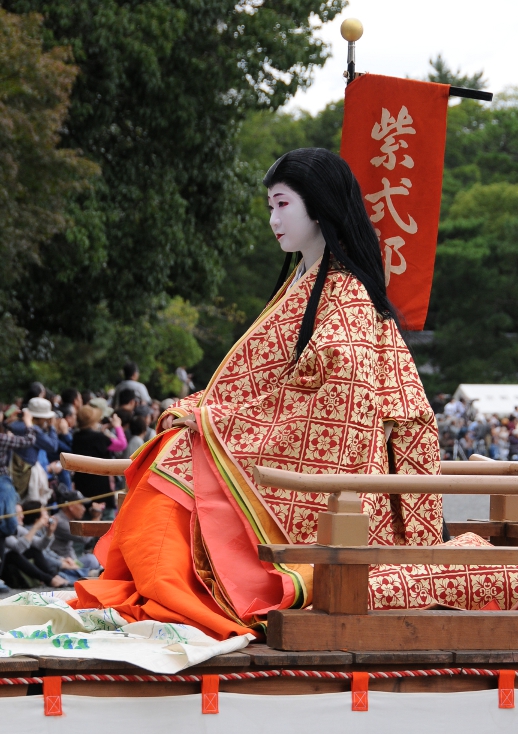 Of course, there are additional props that can’t be missing: samurai on horses accompanied by stable boys and soldiers on foot with weapons ranging from the long rifles of the Meiji era to the swords of the earlier periods. Court ladies in lavish kimono comprised of several layers were carried along on platforms or walk underneath large umbrellas. People carrying flowers or offerings for the shrine followed two mikoshi that held the spirits of the two emperors mentioned above, and a large wagon with undetermined contents was drawn by a black ox. And in between, large groups of people were playing music – on seemingly modern flutes and drums at first, then on instruments that I have only seen during religious ceremonies, and finally there was a lone soldier blowing on a horn made from a large shell.
Of course, there are additional props that can’t be missing: samurai on horses accompanied by stable boys and soldiers on foot with weapons ranging from the long rifles of the Meiji era to the swords of the earlier periods. Court ladies in lavish kimono comprised of several layers were carried along on platforms or walk underneath large umbrellas. People carrying flowers or offerings for the shrine followed two mikoshi that held the spirits of the two emperors mentioned above, and a large wagon with undetermined contents was drawn by a black ox. And in between, large groups of people were playing music – on seemingly modern flutes and drums at first, then on instruments that I have only seen during religious ceremonies, and finally there was a lone soldier blowing on a horn made from a large shell.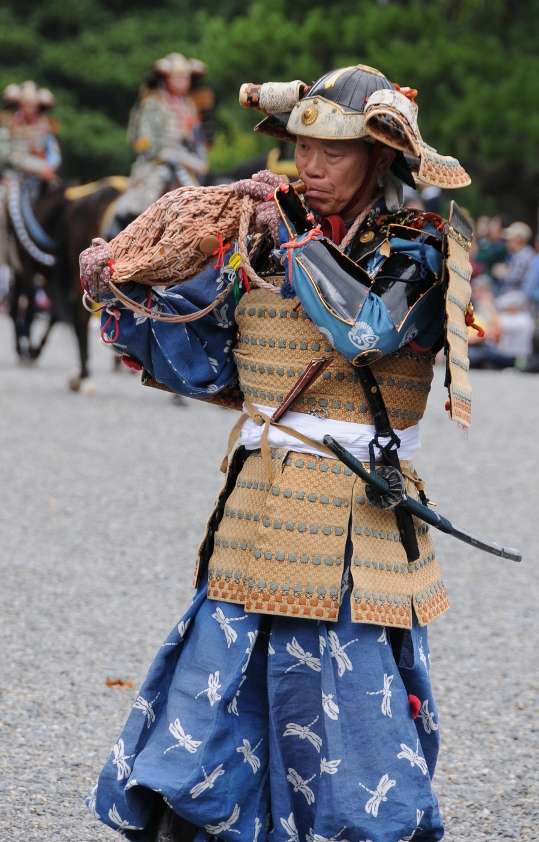 There is an enormous amount of attention paid to every detail of every costume: from the appropriate hairstyle (sometimes accomplished using wigs) to the clothing itself (some of the samurai wore loudly clanging heavy armour) and all the accessories (helmets, jewelry, war fans and weapons, ladles and buckets to water the horses) down to the footwear – boots and sandals made from rice straw. It is a real joy to watch, and it takes – nomen est omen – ages until the procession passes by any one point – more than two hours altogether.
There is an enormous amount of attention paid to every detail of every costume: from the appropriate hairstyle (sometimes accomplished using wigs) to the clothing itself (some of the samurai wore loudly clanging heavy armour) and all the accessories (helmets, jewelry, war fans and weapons, ladles and buckets to water the horses) down to the footwear – boots and sandals made from rice straw. It is a real joy to watch, and it takes – nomen est omen – ages until the procession passes by any one point – more than two hours altogether.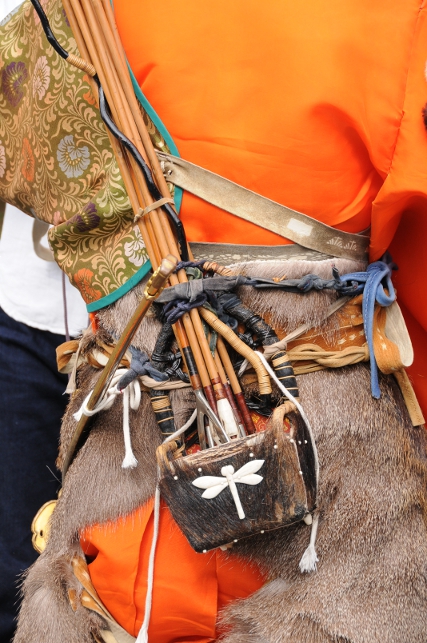 What I found most exciting though was that the participants of the procession gathered on the pathways of the imperial gardens before the start, so you can watch the participants getting dressed, having lunch, or posing for pictures – some of them even selfies 😉 This was different from the Aoi festival in May where the procession started from within the palace and the participants were not seen before. Somehow the fact that they were just gathering “in the open” so to speak, gave me the feeling of a rather relaxed, fun thing – as opposed to Aoi – but maybe that’s because Aoi is more of a religious ritual than Jidai matsuri?
What I found most exciting though was that the participants of the procession gathered on the pathways of the imperial gardens before the start, so you can watch the participants getting dressed, having lunch, or posing for pictures – some of them even selfies 😉 This was different from the Aoi festival in May where the procession started from within the palace and the participants were not seen before. Somehow the fact that they were just gathering “in the open” so to speak, gave me the feeling of a rather relaxed, fun thing – as opposed to Aoi – but maybe that’s because Aoi is more of a religious ritual than Jidai matsuri?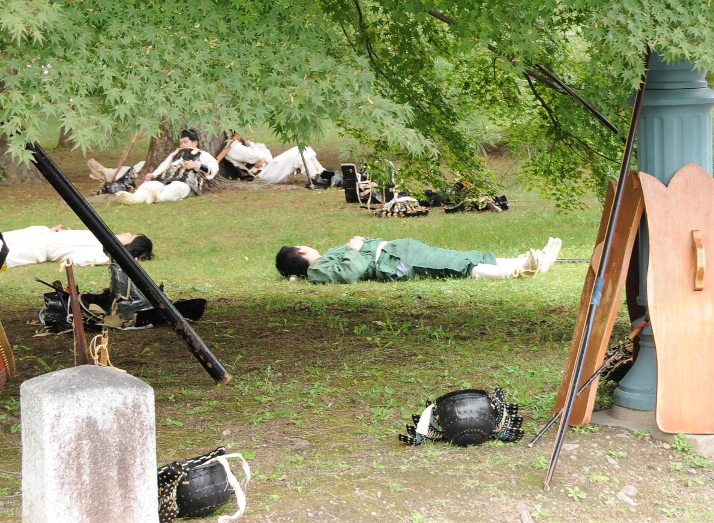
Skip to content
A European's move towards Japan
